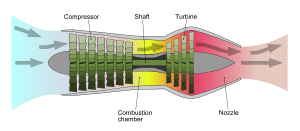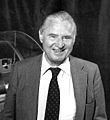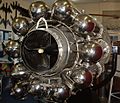Turbojet facts for kids
A turbojet is a type of jet engine that helps airplanes fly. It works by pulling in air, mixing it with fuel, and then burning this mixture. The hot, fast-moving air shoots out the back of the engine, pushing the plane forward. As the air leaves, it spins a special fan called a turbine. This turbine is connected to a gas compressor at the front, which helps suck in and squeeze even more air.
Today, you'll often see turbofan engines on planes. They are a bit more complex but are better because they use less fuel and make less noise than turbojets. However, very fast planes, like those that fly faster than sound, often still use the simpler turbojet engine.
Contents
How a Turbojet Engine Works
A turbojet engine has several important parts that work together to create thrust. Thrust is the force that pushes the airplane forward.
Air Intake
The air intake is at the very front of the engine. It's like the mouth of the engine, where all the air from outside is pulled in. This air is needed for the engine to work.
Air Compressor
After the air enters, it goes into the air compressor. This part is made of many spinning blades called rotors and still blades called stators. The compressor squeezes the air into a much smaller space. This makes the air's pressure and temperature go up a lot. Imagine squeezing a balloon – the air inside gets denser.
Combustion Chamber
Next, the squeezed air moves into the combustion chamber. This is where the magic happens! Fuel is sprayed into this hot, high-pressure air through special tubes. Then, the mixture is set on fire. This creates a very hot, fast-moving gas.
Turbine
After the combustion chamber, the super-hot gas rushes past a fan called the turbine. The gas pushes on the turbine blades, making them spin very fast. This spinning turbine is connected by a shaft to the compressor at the front. So, as the turbine spins, it also makes the compressor spin, pulling in more air and keeping the whole process going.
Nozzle
Finally, the hot, fast-moving gas shoots out the back of the engine through the nozzle. The speed of the gas leaving the nozzle is much faster than the speed of the air that entered the engine. This big difference in speed creates a powerful push, or thrust, that moves the airplane forward.
Afterburner
Some military planes have an extra part called an afterburner. It's located right behind the main engine's nozzle. The afterburner sprays more fuel into the hot gas that's already leaving the engine and burns it again. This gives a huge boost of extra power and speed, but it uses a lot of fuel very quickly. Because of this, afterburners are only used for short bursts, like when a plane needs to go supersonic or take off very quickly.
Related Pages
Images for kids
See also
 In Spanish: Turborreactor para niños
In Spanish: Turborreactor para niños









